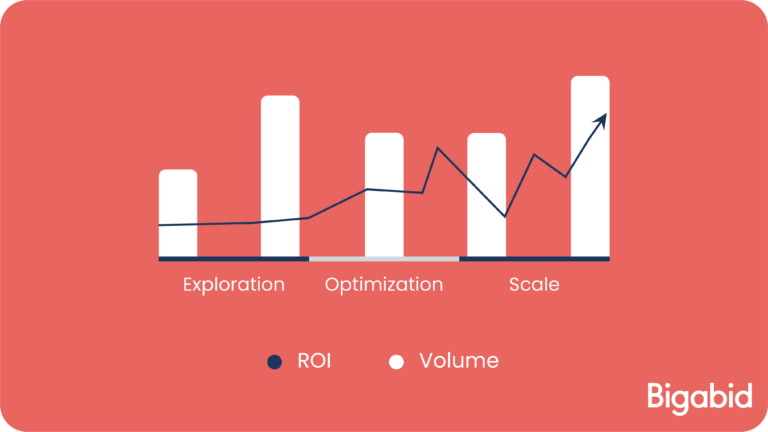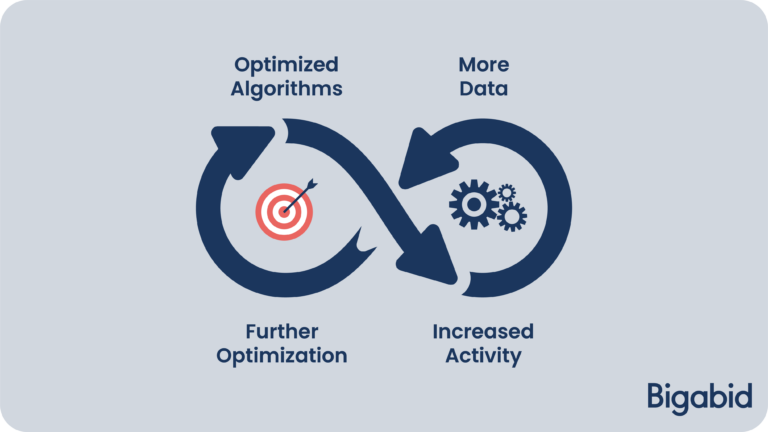How to Ensure a Successful UA and Retargeting Campaign Timeline
By Moran Lev, Senior Director of Customer Success
“Think of the scaling stage as reaching an entry level of quality performance that is then further enhanced for elite performance.“
How to Ensure a Successful UA and Retargeting Campaign Timeline

By Moran Lev, Senior Director of Customer Success
User Acquisition and Retargeting campaigns are powered by robust AI, but consistent results are not instantaneous. Even when implementing Bigabid’s real-time data analysis and hyper-sophisticated algorithms, there is a process that takes time to allow the algorithms to optimize and deliver a consistent ROI.
Discover more about Bigabid’s Real-Time Data Analysis
This holds true for even Facebook and Google. If any DSP (demand-side-platform) promises immediate results, be wary of working with them. It’s the process itself that generates a scalable ROI. This process can be broken down into three stages, which we are going to outline in this article.
We will also address:

Stage 1: Exploration
The exploration stage could more simply be called the learning stage, as that’s exactly what our AI is doing. Bigabid’s AI, capable of handling more than 50TB of raw data in a single day, digests and analyzes thousands of variables to work out exactly what data, deterministic, contextual, behavior, or otherwise, demonstrates the most engagement between thousands of audience categories and ads. It is important to share as many events as possible in this stage. As performance rises so does the ROI, which is even further optimized in the next stage..
Stage 2: Optimization
By the time we reach this stage our ML has learned exactly when and how various audiences will engage with particular ads and will take action when seeing that ad. Now, it’s time for our ML to hyper-focus on the details, making deeper connections between the audiences and ad variables at a much more granular level.
With proprietary tools like Deep Categories, which uniquely categorizes apps into thousands of categories instead of the 50 or so that the app stores use; Real-Time Data Analysis, which analyzes terabytes of data in real-time; and Creative Personalization, which creates thousands of ad variations to find the perfect fit, Bigabid’s Gen-2 DSP can draw out meaningful connections far beyond a typical DSP.
Discover more about: Deep Categories, Real-Time Data Analysis, Creative Personalization, and 2nd Generation DSPs.
With optimized algorithms driving the best possible performance the campaign volume and activity increase, which further increases our ML’s ability to apply what it has learned to more and more audiences to further optimize. This positive feedback loop is what ultimately leads to a consistent positive ROI and scaling.

Stage 3: Scale
When the campaign performance is running on optimal levels and demonstrating a solid incremental ROI, it’s time to scale. Though this is the last phase, by no means does Bigabid’s AI stop learning and refining. Think of the scaling stage as reaching an entry level of quality performance that is further enhanced for elite performance.
During the scaling stage, we not only optimize the campaign towards certain ad placements and inventory, but we also share actionable insights into new avenues for audiences, ad styles, and even app development. Once again, we create a positive feedback loop, ensuring not only a consistent ROI that can scale, but a long-lasting partnership to identify white space for enduring growth.
Bigabid is in the business of both growing apps and growing businesses that grow apps. That’s why many of our clients partner up with us on a larger portion or even the entirety of their portfolio.
To understand the various stages in more detail please check out some of our successful case studies.
How Long Does it take Before the Scale Phase?
This is a popular question and it really comes down to data. The more data Bigabid’s AI can digest and cleanse, the faster the exploration stage. More robust upfront budgets allow for more data collection and the ability for our ML to create predictive models sooner. Smaller upfront budgets can also perform well, but they take more time, as it takes longer to acquire enough data.
We also have to consider the type of app genre, as various apps have more or less frequent events to analyze, and even in the same genre, we tailor our approach as each app is unique. Depending on the campaign KPIs, we look to get as many events as possible to target the ideal audience with the highest affinity. Larger budgets help us achieve this quicker and smaller budgets take more time.
Differences and Similarities in UA and Retargeting Campaigns
Though the campaign phases are the same, whether it’s UA or Retargeting can affect the amount of time it takes to collect data. For UA we can rely on past data for targeting new users while in retargeting we use past data for creating a target list. It’s the same data for different uses, but it can affect the timeline. Basically, we do both UA and RT with a focus on ROI. In RT you can scale faster as you know the target list while in UA you need to create one based on past target lists.
Discover more about Incremental Value in retargeting.
Other Factors That Affect Campaign Timeline
Significant changes made to ad placements, bidding, or creatives will likely affect the available data, and therefore extend the exploration phase. Budget changes, pausing ad sets, or other changes to key events will also of course increase the timeline. Because of this, it is crucial to have an aligned creative strategy upfront based on KPIs to ensure a good balance of creative performance, ROI, and the time it takes for the campaign to ramp up.
In Conclusion
To ramp up your UA or Retargeting campaign both data and time are involved. Even if you have all the data you need, you shouldn’t expect results on day one. It’s crucial for our ML algorithms to test, test, and test some more. Being thorough equals consistent results. Despite this, as discussed there are some factors that contribute to a faster ramp up.
All productive, high-performing campaigns with consistent incremental ROI’s take some time to ramp up. Though the timeline varies, Bigabid ensures that we pick the right time to scale and meet your KPIs. Reach out to us if you have any further questions or if you’re ready to start a successful campaign growing your app.